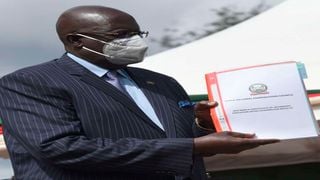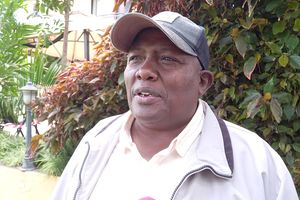
Education Cabinet Secretary George Magoha releases the 2020 KCSE results at Mitihani House in Nairobi on May 10, 2021.
| Evans Habil | Nation Media GroupEducation
Premium
George Magoha to release varsity placement guidelines
What you need to know:
- The students’ portal on the Kenya Universities and Colleges Central Placement Service will then be opened until June 11.
- Nationally, 893 candidates scored a clean A and 6,420 others had A- (minus).
Thousands of varsity hopefuls will today learn about the chances of landing their preferred courses when Education Cabinet Secretary Prof George Magoha issues guidelines of the placement process.
The CS is expected to outline the cut-off points for the various programmes, giving students an opportunity to revise their choices depending on their performance.
The students’ portal on the Kenya Universities and Colleges Central Placement Service (KUCCPS) will then be open until June 11.
They will review their options based on their grades and career aspirations when the portal is on for three weeks. They will also have a chance to change the institutions they wish to attend, according to the programmes on offer.
KUCCPS will analyse the data by considering students’ choices against available places then open a second window for revision before they conclude the process.
Covid-19 pandemic
The Ministry of Education wants to ensure students report in September, having lost about seven months of school time last year due to the Covid-19 pandemic.
The same applies to those joining technical and vocational education and training (Tvet) institutions, teachers’ training colleges and medical schools.
Some 143,140 students scored a mean grade of C+ (plus) and above, the minimum qualification for university admission in the rescheduled 2020 Kenya Certificate of Secondary Examination.
This was a 13.8 per cent rise from the 2019 Class, which qualified 125,746 students for varsity admission.
As expected, most of the top candidates will battle it out for courses traditionally perceived as ‘superior’ such as medicine, engineering, law and computing.
A KUCCPS report shows that out of the 122,831 candidates who were placed in universities last year, 66,661 (54.27 per cent) joined science, technology, engineering and mathematics courses, the majority of them (63.41 per cent) being male.
The University of Nairobi, Kenyatta University, Moi University, Egerton University and Jomo Kenyatta University of Agriculture and Technology tend to attract more students than the newly chartered institutions.
Nationally, 893 candidates scored a clean A and 6,420 others had A- (minus). Some 14,427 candidates had B+ (plus), 25,207 had B, 38,194 had B- (minus) while 57,999 scored a C+ (plus).
The other 600,159 students who scored between C and E, qualify for placement in diploma, certificate and artisan courses.
In placing the candidates, the cut-off points for each programme is usually determined by KUCCPS based on the applicant’s choices and their performance in the relevant subject clusters. Students can use the previous cut-off points as a guide.
Prof Magoha had earlier announced that varsities, colleges and Tvet institutions have enough places for all candidates.
Over the recent past, the government has been placing and sponsoring some students in private universities to ensure that all those who qualify transition to higher education.
“I have directed KUCCPS to ensure proper public mobilisation and communication campaigns are put in place to ensure all interested candidates apply to colleges and TVET institutions of their choice,” Prof Magoha said.
Reduced funding
However, the increase in the number of students qualifying for varsity courses comes in the wake of reduced funding by the exchequer. The 2021/2022 budgetary allocation for universities has been slashed by Sh9.4 billion.
In the current budget, universities had been allocated Sh109.3 billion but the Treasury has reduced it to ShSh99.9 billion. The budgets for the middle-level colleges have also been substantially reduced.
The Higher Education Loans Board has also warned that 95,000 students may miss out on loans that many of them depend on for upkeep, following a reduction of its budget by Sh2.2 billion.
The board has also had a tough year financially as it failed to recover Sh1 billion from past students, mainly due to the effects of the pandemic.
The government has invested heavily in the expansion of technical training institutions to offer more opportunities to students.
The number of technical training institutes (TTIs) in each constituency has grown from 52 in 2013 to 233. Out of these, 52 are fully operational, 140 have been built, equipped and staffed. Four of them cater for Tvet students with special learning needs. About 41 are under construction.





